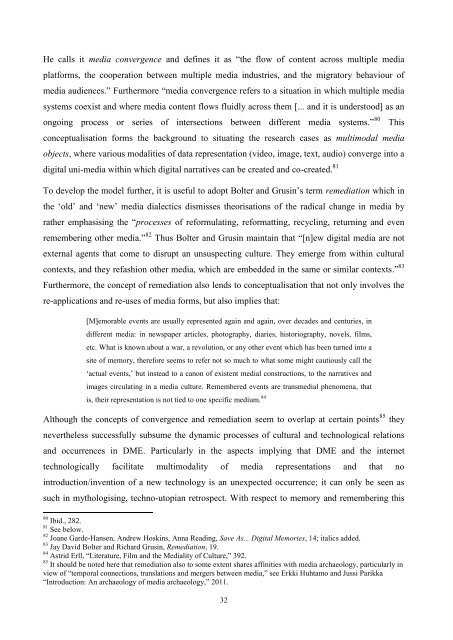UNIVERSITY OF NOVA GORICA GRADUATE SCHOOL ...
UNIVERSITY OF NOVA GORICA GRADUATE SCHOOL ...
UNIVERSITY OF NOVA GORICA GRADUATE SCHOOL ...
You also want an ePaper? Increase the reach of your titles
YUMPU automatically turns print PDFs into web optimized ePapers that Google loves.
He calls it media convergence and defines it as ―the flow of content across multiple media<br />
platforms, the cooperation between multiple media industries, and the migratory behaviour of<br />
media audiences.‖ Furthermore ―media convergence refers to a situation in which multiple media<br />
systems coexist and where media content flows fluidly across them [... and it is understood] as an<br />
ongoing process or series of intersections between different media systems.‖ 80 This<br />
conceptualisation forms the background to situating the research cases as multimodal media<br />
objects, where various modalities of data representation (video, image, text, audio) converge into a<br />
digital uni-media within which digital narratives can be created and co-created. 81<br />
To develop the model further, it is useful to adopt Bolter and Grusin‘s term remediation which in<br />
the ‗old‘ and ‗new‘ media dialectics dismisses theorisations of the radical change in media by<br />
rather emphasising the ―processes of reformulating, reformatting, recycling, returning and even<br />
remembering other media.‖ 82 Thus Bolter and Grusin maintain that ―[n]ew digital media are not<br />
external agents that come to disrupt an unsuspecting culture. They emerge from within cultural<br />
contexts, and they refashion other media, which are embedded in the same or similar contexts.‖ 83<br />
Furthermore, the concept of remediation also lends to conceptualisation that not only involves the<br />
re-applications and re-uses of media forms, but also implies that:<br />
[M]emorable events are usually represented again and again, over decades and centuries, in<br />
different media: in newspaper articles, photography, diaries, historiography, novels, films,<br />
etc. What is known about a war, a revolution, or any other event which has been turned into a<br />
site of memory, therefore seems to refer not so much to what some might cautiously call the<br />
‗actual events,‘ but instead to a canon of existent medial constructions, to the narratives and<br />
images circulating in a media culture. Remembered events are transmedial phenomena, that<br />
is, their representation is not tied to one specific medium. 84<br />
Although the concepts of convergence and remediation seem to overlap at certain points 85 they<br />
nevertheless successfully subsume the dynamic processes of cultural and technological relations<br />
and occurrences in DME. Particularly in the aspects implying that DME and the internet<br />
technologically facilitate multimodality of media representations and that no<br />
introduction/invention of a new technology is an unexpected occurrence; it can only be seen as<br />
such in mythologising, techno-utopian retrospect. With respect to memory and remembering this<br />
80 Ibid., 282.<br />
81 See below.<br />
82 Joane Garde-Hansen, Andrew Hoskins, Anna Reading, Save As... Digital Memories, 14; italics added.<br />
83 Jay David Bolter and Richard Grusin, Remediation, 19.<br />
84 Astrid Erll, ―Literature, Film and the Mediality of Culture,‖ 392.<br />
85 It should be noted here that remediation also to some extent shares affinities with media archaeology, particularly in<br />
view of ―temporal connections, translations and mergers between media,‖ see Erkki Huhtamo and Jussi Parikka<br />
―Introduction: An archaeology of media archaeology,‖ 2011.<br />
32

















